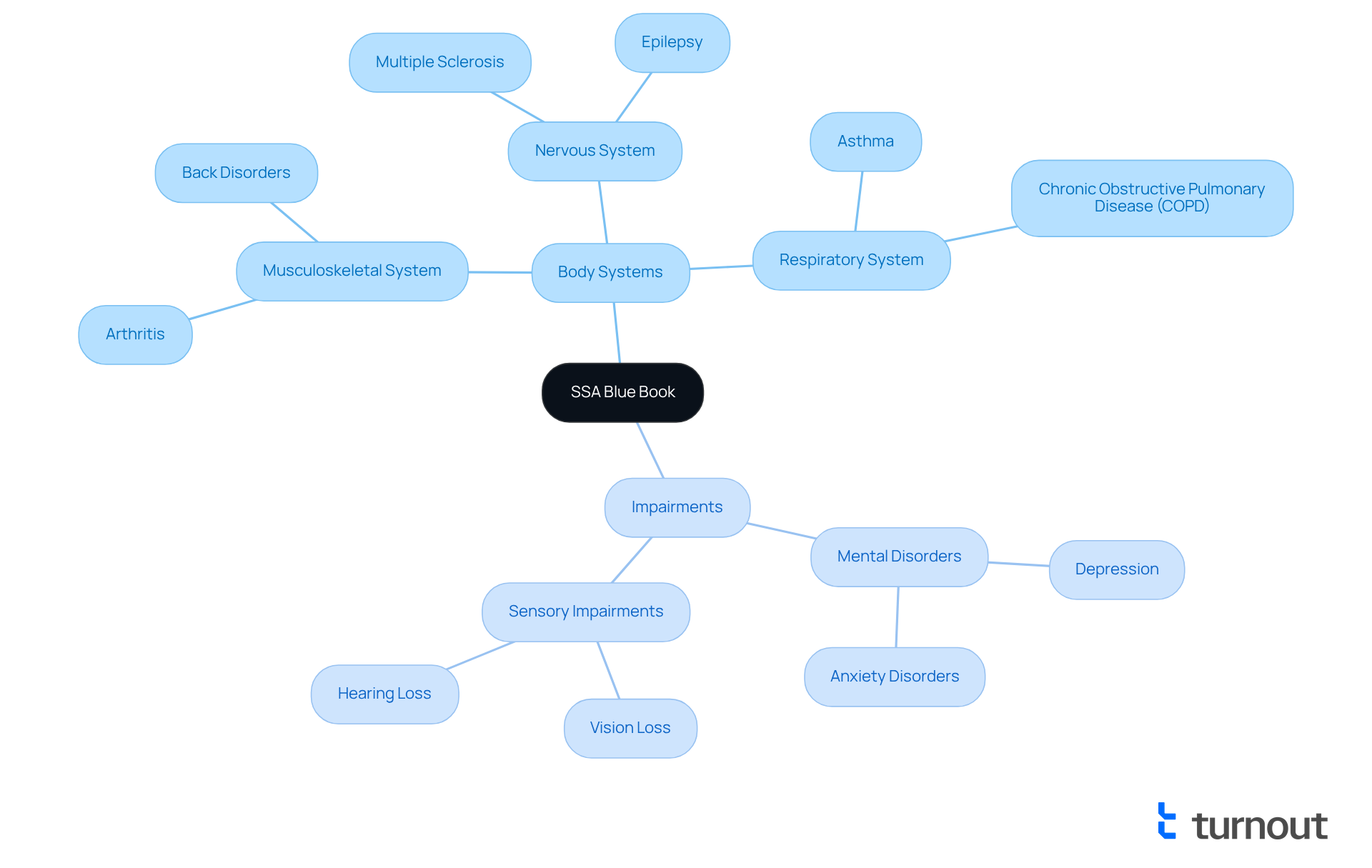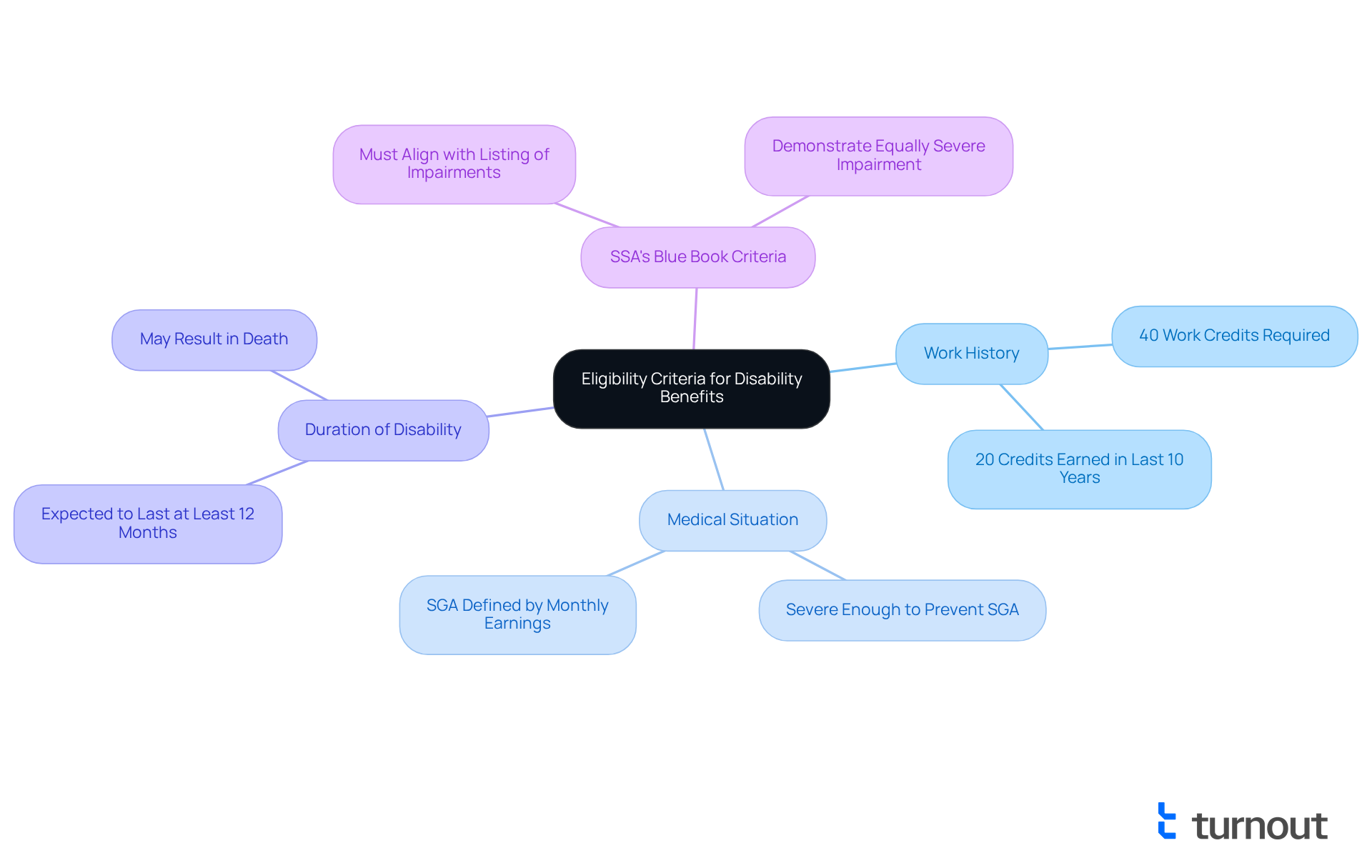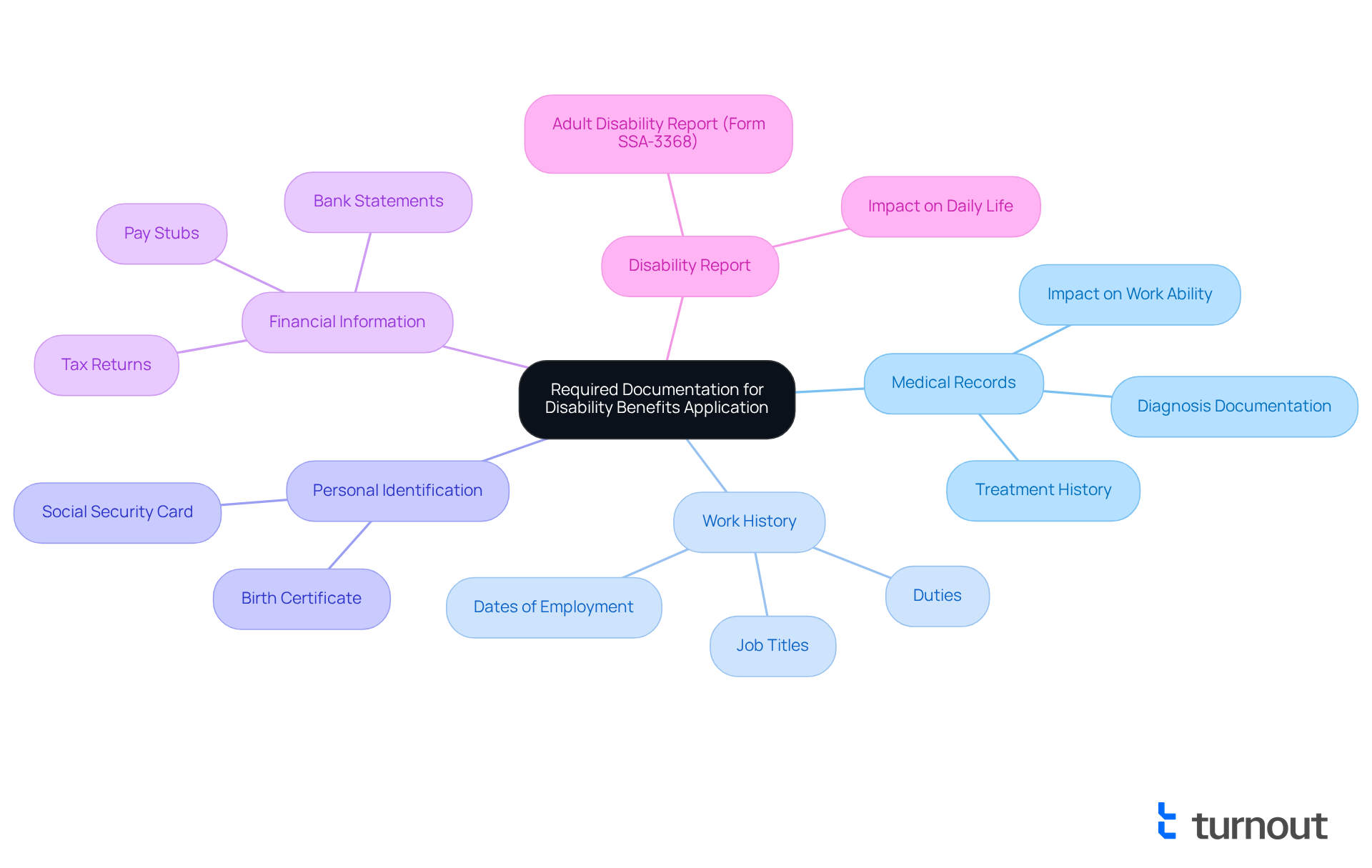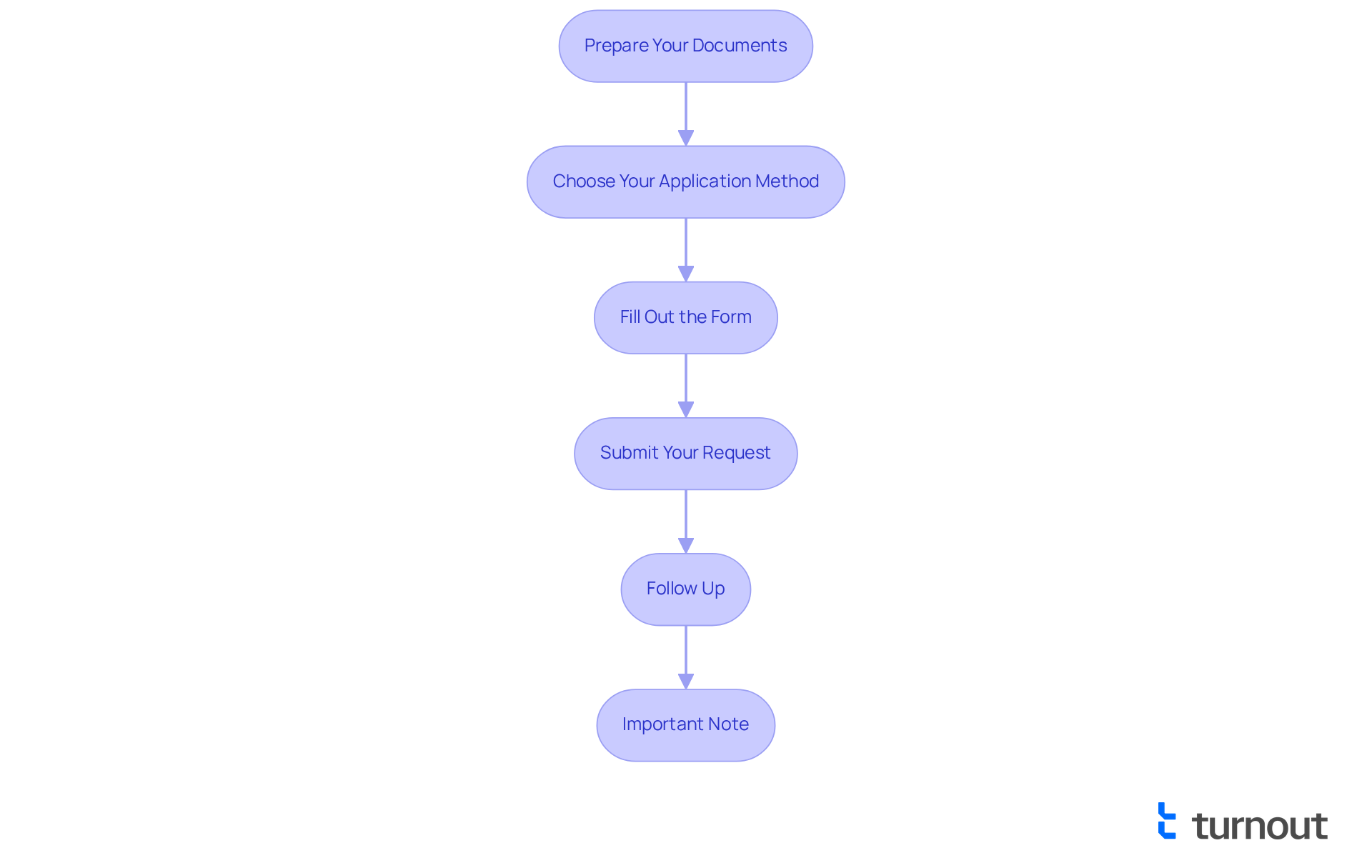Overview
Navigating the disability benefits process can feel overwhelming, but the SSA's Blue Book is here to guide you. This essential resource outlines the medical conditions considered disabling and the specific criteria needed for a successful claim. Understanding the Blue Book's guidelines is vital; it empowers applicants to gather the necessary documentation and meet eligibility criteria. By doing so, you enhance your chances of receiving the benefits you deserve. Remember, you are not alone in this journey, and we're here to help you every step of the way.
Introduction
Navigating the complexities of disability benefits can feel overwhelming, especially when the stakes are high for those seeking support. We understand that this journey is challenging, and that’s why the SSA's Blue Book is such an essential resource. This guide details the medical conditions recognized as disabling by the Social Security Administration, and it serves as a vital tool for applicants. By familiarizing yourself with its contents, you can prepare your claims more effectively and enhance your chances of success.
However, with numerous eligibility criteria and documentation requirements, it’s common to feel lost or unsure. What steps can you take to leverage this resource effectively? How can you avoid common pitfalls in the application process? We’re here to help you navigate these questions and empower you on your journey.
Understand the SSA Blue Book and Its Importance
The resource known as the SSA's blue book, formally titled 'Disability Evaluation Under Social Security,' is essential for many. It details the medical conditions that the SSA considers disabling. This comprehensive guide is organized into sections that address different body systems and the specific impairments that may qualify for benefits.
We understand that navigating the disability benefits process can be overwhelming. Familiarizing yourself with SSA's blue book is essential if you are applying for disability benefits. It outlines the criteria that must be met for a successful claim, helping you determine if your situation is included.
By getting acquainted with SSA's blue book, you'll gain clarity on what evidence you need to support your application. Remember, you are not alone in this journey. You can access SSA's blue book online at the official SSA website, where it is regularly updated to reflect current medical standards and practices. We're here to help you take this important step toward securing the support you need.

Identify Eligibility Criteria for Disability Benefits
Navigating the process of qualifying for Social Security Disability Insurance (SSDI) can feel overwhelming. We understand that this journey may come with many questions and concerns. To help you, let’s explore the specific criteria set by the SSA that you need to meet:
- Work History: It's essential that you have worked in jobs covered by Social Security and earned enough work credits. Typically, this means accumulating 40 credits, with at least 20 earned in the last 10 years.
- Medical Situation: Your condition must be severe enough to prevent you from engaging in substantial gainful activity (SGA). The SSA defines SGA as earning more than a certain amount each month, which is adjusted annually.
- Duration of Disability: Your disability should be expected to last at least 12 months or result in death.
- Your situation must align with the SSA's blue book criteria for the listing of impairments. Even if your impairment isn’t listed, you can still qualify by demonstrating that it is equally severe.
Understanding these criteria is an important step in assessing your eligibility and preparing for the application process. Remember, you are not alone in this journey; we’re here to help you every step of the way.

Gather Required Documentation for Your Application
When applying for disability benefits, it’s important to gather several key documents, such as those listed in SSA's blue book, that can support your claim. We understand that this can feel overwhelming, but having everything organized can make a significant difference. Here’s what you’ll need:
- Medical Records: Comprehensive documentation from your healthcare providers that describe your diagnosis, treatment history, and how your health status impacts your ability to work.
- Work History: A detailed account of your employment history, including job titles, duties, and dates of employment.
- Personal Identification: Proof of identity, such as a birth certificate or Social Security card.
- Financial Information: Documentation of your income and resources, which may include tax returns, bank statements, and pay stubs.
- Disability Report: Complete the Adult Disability Report (Form SSA-3368), which is detailed in SSA's blue book and provides the SSA with information about your condition and its impact on your daily life.
Arranging these documents in advance will not only simplify your submission process but also help prevent unnecessary delays. Remember, you are not alone in this journey; we’re here to help you every step of the way.

Complete the Application Process Step-by-Step
To successfully complete your application for disability benefits, we’re here to guide you through the process with care and understanding. Follow these steps to enhance your chances of a favorable outcome:
-
Prepare Your Documents: Start by gathering all necessary documentation, including medical records, personal identification, and any relevant work history. Having these ready will make the process easier for you.
-
Choose Your Application Method: You have options for applying: online through the SSA website, by phone, or in person at your local SSA office. Generally, online submissions are quicker, with an average processing time of about 225 days for initial decisions. However, it’s important to be aware that as of November 2023, the average wait time for new applicants, as noted in SSA's blue book, has increased significantly, now exceeding seven months.
-
Fill Out the Form: When completing the SSA-16 form, accuracy is essential. Provide detailed information about your medical condition, work history, and how your disability affects your daily life. We understand that thoroughness in this section is crucial, especially since three out of five candidates face denial after waiting over seven months for an initial decision regarding SSA's blue book.
-
Submit Your Request: After you’ve filled out the form, submit your request along with all supporting documents. If you’re applying online, follow the prompts to upload your documents securely.
-
Follow Up: Once you’ve submitted your application, it’s important to monitor your status regularly. You can check online or contact the SSA for updates. Be prepared to provide additional information if requested; this can help expedite your process.
Important Note: Please be aware that as of March 31, 2025, new identity verification requirements will take effect. This means applicants will need to verify their identity either online or in person. Understanding this change is vital, as it may impact how you finalize your submission.
By following these steps, you can ensure that your submission is comprehensive and well-prepared. Remember, you are not alone in this journey, and we are here to help you every step of the way.

Troubleshoot Common Application Challenges
Navigating the application process for disability benefits, as detailed in SSA's blue book, can feel overwhelming, and it's common for applicants to face various challenges. We understand that this journey can be tough, so here are some supportive strategies to help you troubleshoot these issues effectively:
-
Insufficient Medical Evidence: Comprehensive medical records are essential for demonstrating the severity of your ailment. If your documentation lacks detail, we encourage you to proactively request additional information from your healthcare providers. Successful claims often include diagnostic test results, such as MRIs or X-rays, that clearly illustrate how your condition impacts your life.
-
Incomplete Submission: It's vital to thoroughly review your submission to ensure all sections are completed. Missing information can lead to unnecessary delays or even denials. Consider using a checklist to confirm that every necessary detail is included, minimizing the risk of oversight and helping you feel more confident in your application.
-
Denial of Claim: If your claim is denied, take a moment to carefully examine the denial notice to understand the specific reasons behind the decision. Remember, you have the right to appeal. Addressing the issues raised in the notice is crucial. Statistics show that approximately 53% of applicants who appeal their initial decision ultimately receive approval, highlighting the importance of a well-prepared appeal.
-
Communication Issues: Maintaining proactive communication with the Social Security Administration (SSA) is essential. If you have questions or need clarification about your submission, don’t hesitate to reach out to their representatives. Clear communication can help resolve misunderstandings and keep your application on track.
-
Time Delays: Patience is key, as the process can be lengthy. Non-expedited requests can take months or even years. Keeping meticulous records of all correspondence and following up regularly can help you stay informed about your status. Understanding this timeline will assist you in managing your expectations.
By recognizing these challenges and employing these strategies from SSA's blue book, you can enhance your chances of successfully navigating the SSDI application process. Remember, you're not alone in this journey, and we're here to help.

Conclusion
Mastering the SSA's Blue Book is crucial for anyone seeking disability benefits. This comprehensive guide serves as a roadmap, outlining the medical conditions and eligibility criteria necessary for a successful claim. We understand that navigating the often complex application process can feel overwhelming. By familiarizing yourself with the nuances of the Blue Book, you can approach this journey with greater confidence and clarity.
Throughout this article, we have highlighted key elements that can make a difference in your experience. Familiarizing yourself with the eligibility criteria is essential, as is gathering the necessary documentation. Following a step-by-step approach to the application process can significantly enhance your chances of a favorable outcome. It's common to encounter challenges, such as insufficient medical evidence or communication issues, but remember that addressing these obstacles is vital for your success.
Ultimately, the journey toward securing disability benefits can be daunting, but it is achievable with the right tools and information. Engaging with the SSA's Blue Book empowers you to understand your rights and requirements, fostering a sense of agency in your pursuit of support. Taking proactive steps and seeking assistance when needed can lead to successful claims, ensuring that you receive the benefits you deserve. Remember, you are not alone in this journey; we're here to help you every step of the way.
Frequently Asked Questions
What is the SSA Blue Book and why is it important?
The SSA Blue Book, formally titled 'Disability Evaluation Under Social Security,' is a resource that details the medical conditions the SSA considers disabling. It is important because it outlines the criteria necessary for a successful disability benefits claim and helps applicants understand what evidence is needed to support their application.
How is the SSA Blue Book organized?
The SSA Blue Book is organized into sections that address different body systems and the specific impairments that may qualify for benefits.
Where can I access the SSA Blue Book?
You can access the SSA Blue Book online at the official SSA website, where it is regularly updated to reflect current medical standards and practices.
What are the eligibility criteria for Social Security Disability Insurance (SSDI)?
The eligibility criteria for SSDI include having a work history with enough Social Security work credits (typically 40 credits, with at least 20 earned in the last 10 years), having a medical condition severe enough to prevent substantial gainful activity (SGA), and having a disability expected to last at least 12 months or result in death.
What does substantial gainful activity (SGA) mean?
Substantial gainful activity (SGA) is defined by the SSA as earning more than a certain amount each month, which is adjusted annually.
Can I qualify for SSDI if my impairment is not listed in the SSA Blue Book?
Yes, you can still qualify for SSDI even if your impairment isn’t listed in the SSA Blue Book by demonstrating that your condition is equally severe.
How can I prepare for the application process for disability benefits?
Understanding the criteria outlined in the SSA Blue Book and assessing your eligibility based on your work history, medical situation, and duration of disability are important steps in preparing for the application process.




